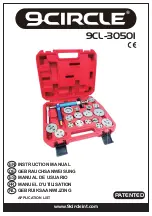
7
6. Adjust the air compressor’s output regulator so that the air output is enough to properly
power the tool, but the output will not exceed the tool s maximum air pressure at any time.
Adjust the pressure gradually, while checking the air output gauge to set the right pressure
range.
7. Inspect the air connections for leaks. Repair any leaks found.
8. If the tool will not be used at this time, turn off and detach the air supply, safely discharge any
residual air pressure, and release the trigger to prevent accidental operation.
Note:
Residual air pressure should not be present after the tool is disconnected from the air
supply. However, it is a good safety measure to attempt to discharge the tool in a safe fashion
after disconnecting to ensure that the tool is disconnected and not powered.
WARNING:
Read the ENTIRE important operating instructions before set-up or use of this product.
Inspect tool before use, looking for damaged, loose, and missing parts. If any problems are found, do not
use the tool until it has been repaired.
#
Descripti
F
A
Air Hose
Connects air source to tool
B
Filter
Prevents dirt and condensation from damaging tool or work piece
C
Regulator
Adjusts air pressure on tool
D
Lubricator
(Optional)
Air tool lubrication
E
Coupler
and Plug
Provides quick connection and release
F
Leader
Hose
Increases coupler life
G
Air
Cleaner/Dr
Prevents water vapor from damaging work piece
H
Air
Adjusting
V l
Fine tuning airflow at tool






























